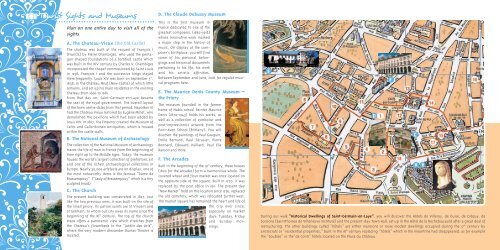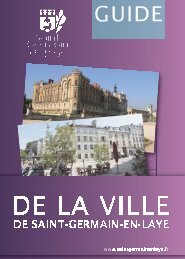Mise en page 1 - Office de Tourisme de Saint-Germain-en-Laye
Mise en page 1 - Office de Tourisme de Saint-Germain-en-Laye
Mise en page 1 - Office de Tourisme de Saint-Germain-en-Laye
You also want an ePaper? Increase the reach of your titles
YUMPU automatically turns print PDFs into web optimized ePapers that Google loves.
52293 Depliant GB_<strong>de</strong>pliant St <strong>Germain</strong> GB 04/05/2010 14:07 Page3Tourist Sights and MuseumsPlan on one <strong>en</strong>tire day to visit all of thesightsA. The Chateau-Vieux (the Old Castle)The chateau was built at the request of François I(Francis) by Pierre Chambiges, who used the p<strong>en</strong>tagon-shapedfoundations of a fortified castle whichwas built in the XIV c<strong>en</strong>tury by Charles V. Chambigesincorporated the chapel commissioned by <strong>Saint</strong> Louisin 1238. François I and the successive kings stayedthere frequ<strong>en</strong>tly. Louis XIV was born on September 5 th ,1638, in the Château Neuf (New Castle) of which littleremains, and set up his main resid<strong>en</strong>ce in the existingchateau from 1666 to 1681.From that day on, <strong>Saint</strong>-<strong>Germain</strong>-<strong>en</strong>-<strong>Laye</strong> becamethe seat of the royal governm<strong>en</strong>t. The overall layoutof the town c<strong>en</strong>tre dates from that period. Napoléon IIIhad the Chateau Vieux restored by Eugène Millet, who<strong>de</strong>molished the pavilions which had be<strong>en</strong> ad<strong>de</strong>d byLouis XIV. In 1867, the Emperor created the Museum ofCeltic and Gallo-Roman Antiquities, which is housedwithin the castle walls.B. The National Museum of ArchaeologyThe collection of the National Museum of Archaeologytraces the life of man in France from the beginning oftime right up to the Middle Ages. Today, the museumhouses the world’s largest collection of prehistoric artand one of the richest archaeological collections inEurope. Nearly 30,000 artefacts are on display, one ofthe most noteworthy items is the famous “Dame <strong>de</strong>Brassempouy” (“Lady of Brassempouy” which is a tinysculpted head).C. The ChurchThe pres<strong>en</strong>t building was consecrated in 1827. Justlike the two previous ones, it was built on the site ofthe small priory. Its patron saints are St Vinc<strong>en</strong>t andSt <strong>Germain</strong>, to whom our city owes its name since thebeginning of the XI th c<strong>en</strong>tury. The top of the churchsteps offers a panoramic view which stretches fromthe Chateau’s flowerbeds to the “Jardin <strong>de</strong>s Arts”,where the very mo<strong>de</strong>rn Alexan<strong>de</strong>r Dumas Theatre islocated.D. The Clau<strong>de</strong> Debussy MuseumThis is the first museum inFrance <strong>de</strong>dicated to one of thegreatest composers, (1862-1918)whose innovative work markeda major step in the history ofmusic. On display at the composer’sbirthplace, you will findsome of his personal belongingsand historical docum<strong>en</strong>tspertaining to his life, his workand his artistic affinities.Betwe<strong>en</strong> September and June, look for regular musicalprograms here.E. The Maurice D<strong>en</strong>is County Museum –the PrioryThe museum foun<strong>de</strong>d in the formerhome of Nabis school Painter MauriceD<strong>en</strong>is (1870-1943) holds his works, aswell as a collection of symbolist andpost-impressionist artwork from thePont-Av<strong>en</strong> School (Brittany). You willdiscover the paintings of Paul Gauguin,Emile Bernard, Paul Sérusier, PierreBonnard, Edouard Vuillard, Paul ElieRanson and more.F. The Arca<strong>de</strong>sBuilt in the beginning of the 19 th c<strong>en</strong>tury, these houses(1820 for the arca<strong>de</strong>s) form a harmonious whole. Thecovered wheat and flour market was once located onthe opposite si<strong>de</strong> of the square. Built in 1770, it wasreplaced by the post office in 1911. The pres<strong>en</strong>t day“New Market” held on this location since 1776, replacedthe old cemetery, which was relocated further west.The market square has remained the heart and life ofthe city ever since,especially on marketdays: Tuesday, Fridayand Sunday mornings.During our walk “Historical Dwellings of <strong>Saint</strong>-<strong>Germain</strong>-<strong>en</strong>-<strong>Laye</strong>”, you will discover the Hôtels <strong>de</strong> Villeroy, <strong>de</strong> Guise, <strong>de</strong> Créquy, <strong>de</strong>Soissons (<strong>Saint</strong>Thomas <strong>de</strong> Vill<strong>en</strong>euve Institute) and the pres<strong>en</strong>t-day Town Hall, set up in the Hôtel <strong>de</strong> la Rochefoucauld after a great <strong>de</strong>al ofrestructuring. The other buildings called “hôtels” are either mansions or more mo<strong>de</strong>st dwellings occupied during the 17 th c<strong>en</strong>tury byaristocrats or “resid<strong>en</strong>tial properties,” built in the 18 th c<strong>en</strong>tury replacing “hôtels” which in the meantime had disappeared, as for examplethe “Soubise” or the“<strong>de</strong> Conti” hôtels located on the Place du Château.







